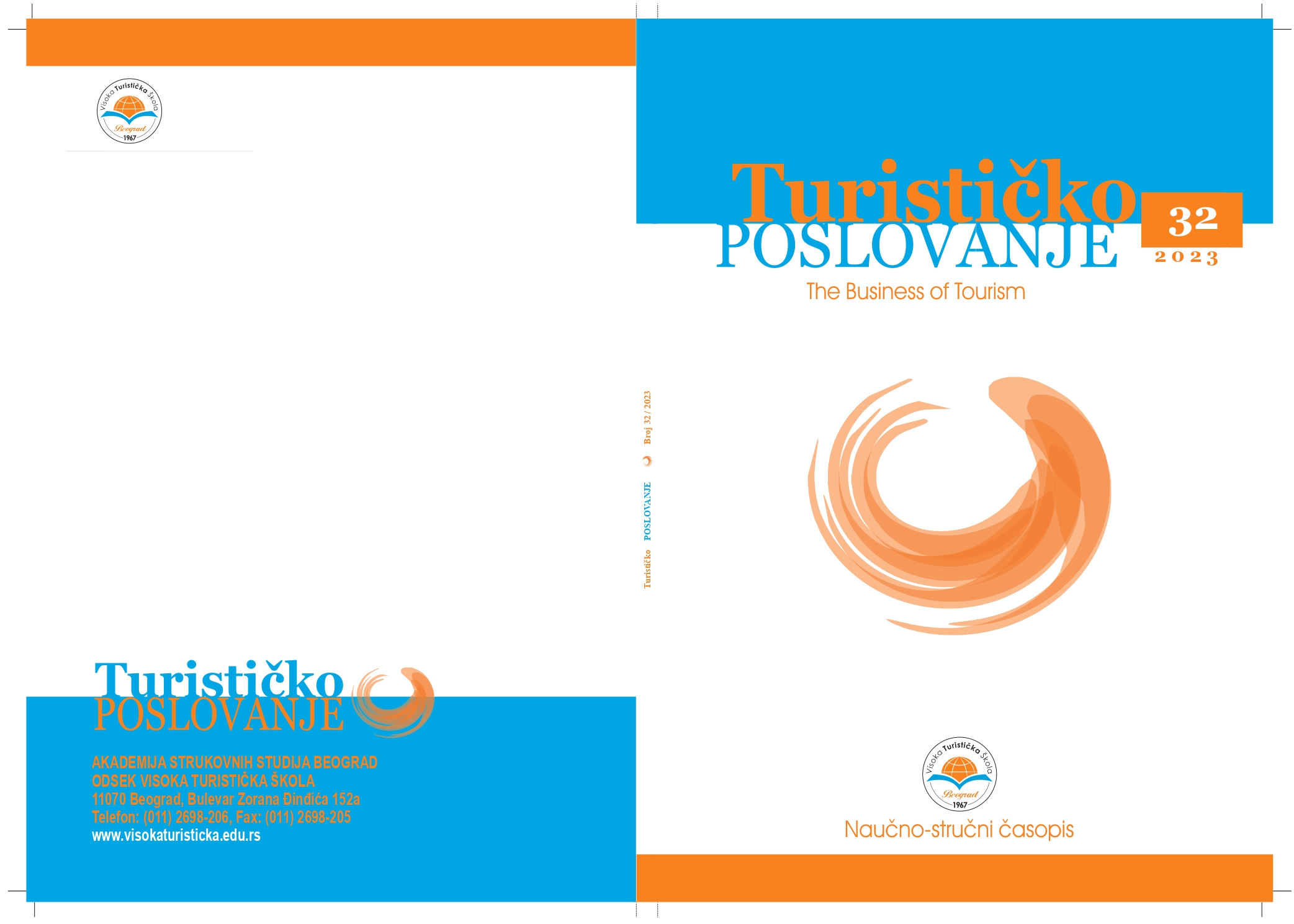DOPRINOS SEKTORA TURIZMA NEUTRALISANJU EKSTERNE NERAVNOTEŽE U ZEMLJAMA ZAPADNOG BALKANA
Sažetak
Izuzev doprinosa ekonomskom rastu i razvoju nacionalne ekonomije, sektor turizma može predstavljati važan faktor reduciranja platnobilansne neravnoteže. Zahvaljujući višem izvozu u poređenju sa uvozom turističkih usluga stvaraju se uslovi za ostvarenje suficita u razmeni turističkih usluga koji mogu biti značajan izvor finansiranja deficita tekućeg računa. Za zemlje Zapadnog Balkana ovo može biti posebno važno budući da se one odlikuju platnobilansnom neravnotežom, ali i ujedno poseduju značajne turističke potencijale koji se dodatno mogu valorizovati u cilju smanjenja deficita tekućeg računa i ublažavanja problema eksterne neravnoteže. Imajući navedeno u vidu, u radu se nastoji kvantifikovati doprinos sektora turizma u finansiranju deficita tekućeg računa zemalja Zapadnog Balkana u periodu 2007-2022. godina. Rezultati istraživanja sugerišu da značaj sektora turizma, kao faktora finansiranja platnobilansne neravnoteže, značajno varira među analiziranim ekonomijama, pri čemu je u svim posmatranim zemljama evidentiran pozitivan doprinos sektora turizma u neutralisanju deficita tekućeg računa. Izuzev navedenog, istraživanjem se nastoji ukazati da postoji značajan potencijal ne samo za razvoj turističkog potencijala u zemljama Zapadnog Balkana, već i za njegov izraženiji doprinos u reduciranju platnobilansne neravnoteže kao jednog od ključnih razvojnih ograničenja posmatranih privreda.
Reference
1. Alp, E., & Gene, E. (2015). The relation between current account deficit and tourism: The case of Turkey. International Journal of Economics and Financial Issues, 5(2), 448–453.
2. Bacović, M., Jaćimović, D., & Cerović-Smolović, J. (2020). Impact of export of travel services on current account balance and growth in Mediterranean countries. Prague Economic Papers, 29(6), 710–728. https://doi.org/10.18267/j.pep.748
3. Benner M., (2020). Tourism in the context of smart specialization: The example of Montenegro. Current Issues in Tourism 23(21). 2624-2630, https://doi.org/10.1080/13683500.2019.1687663
4. Čakajac, B., Janković, N., & Luković, S. (2023). The Role of Remittances in Financing the Current Account Deficit: The Case of Serbia. Naše gospodarstvo/Our Economy, 69(3), 35-44. https://doi.org/10.18690/10.2478/ngoe-2023-0016
5. Čerović S., Knežević M., Matović V., Brdar I., (2015). The Contribution of Tourism Industry on the GDP growth of Western Balkan Countries. Industrija, 43(3), 159-170. http://dx.doi.org/10.5937/industrija43-9002
6. Devadas S., Loyaza N., (2018). When Is a Current Account Deficit Bad, World Bank Group, Research&Policy Briefs, No 17, Dostupno na: https://documents1.worldbank.org/curated/en/507731538487989157/pdf/130415-BRI-PUBLIC-ADD-SERIES-When-is-a-current-account-deficit-bad.pdf
7. Gidey, K. (2021). The effect of tourism on current account balance in Ethiopia. Journal of African Development Studies, 8(2), 5–20. https://doi.org/10.56302/jads.v8i2.3257
8. Gričar S., Bojnec Š., Karadžić V., Backović Vulić T., (2021). Tourism-led economic growth in Montenegro and Slovenia. Economic Research. 34(1), 3401-3420, https://doi.org/10.1080/1331677X.2021.1875858
9. Hristov Stančić B., Đorđević A., Kovačević I., Zečević B., (2022). Tourism-led economic growth hypothesis- an empirical investigation for Serbia. Teme 46(1). 251-267 https://doi.org/10.22190/TEME210217014H
10. International Monetary Fund (2023). Balance of Payments and International Investment Position Statistics, available at: https://data.imf.org/?sk=7a51304b-6426-40c0-83dd-ca473ca1fd52
11. Janković, N. (2015). A twin deficit: The issue of the Serbian economy. Economic Horizons, 17(2), 109–124. https://doi.org/10.5937/ekonhor1502109J
12. Janković N., Čakajac B., (2022). Uloga stranih direktnih investicija u finansiranju deficit tekućeg računa Republike Srbije. U Veselinović P., Kostić M., (2022). Institucionalne promene kao determinanta privrednog razvoja Republike Srbije, Ekonomski fakultet Kragujevac, 371-394.
13. Janković, N., Čakajac, B., Luković, S., & Mitrašević, M. (2022). Sektor turizma kao faktor smanjenja deficita platnog bilansa Republike Srbije. Menadžment u hotelijerstvu i turizmu, 10(2), 137-151. https://doi.org/10.5937/menhottur2202137J
14. Kalinović M., Todorović M., Marković I., (2022). The significance of ICT services for the balance of payments in the Republic of Serbia. Economic Themes 60(2). 187-204 https://doi.org/10.2478/ethemes-2022-0011
15. Kovačević, R. (2017). Financing the current account deficit in Southeastern European countries. Banking, 46(3), 96–111. https://doi.org/10.5937/bankarstvo1703096K 17.
16. Kovačević R., (2017). Current Account Determinants in Southeast European (SEE) Countries- Panel Approach. Zbornik radova Ekonomskog fakulteta u Rijeci, časopis za teoriju i praksu. 35(2), 391-424. https://doi.org/10.18045/zbefri.2017.2.391
17. Kovačević, R. (2020). The causal relationship between current account and financial account balance in Western Balkan countries: The case of Serbia. Banking 49(4), 9– 41. https://doi.org/10.5937/bankarstvo2004009K 18.
18. Kruja, A. (2012). The Impact of Tourism Sector Development in the Albanian Economy, Economia. Seria Management 15(1), 204-218.
19. Lorde, T., Lowe, S., & Francis, B. (2010). Do tourism receipts contribute to the sustainability of current account deficits in Barbados? Working Paper, CBB, 1– 36
20. Meyer, D., & Shera, A. (2015). Remittances' impact on the labor supply and the deficit of current account. BERG Working Paper Series, 97. Bamberg University.
21. Ozer M., Žugić J., Tomaš- Miskin S., (2018). The Relationship between Current Account Deficits and Growth in Montenegro: ARDL Bounds Testing Approach. Journal of Central Banking Theory and Practice, No. 3, 5-24, DOI: 0.2478/jcbtp-2018-0020
22. Pantić N., Milojević I., (2019). Investments and employment in tourism in the Republic of Serbia. Hotel and Tourism Management, 7(1), 95-104, doi:10.5937/menhottur1901095P
23. Porfido E., (2020). Tourism Development in the Western Balkans: Towards a Comon Policy, Annual Review of Territorial Governance in the Western Balkans, No 2. 24-45, https://doi.org/10.32034/CP-TGWBAR-I02-03
24. Radukić S., Petrović-Ranđelović M., Petrović J., (2022). The impact of Covid-19 pandemic on tourism development in Western Balkan countries. Horizons- International Scientific Journal 31(2). 291-301, https://doi.org/10.20544/HORIZONS.A.31.2.22.P22
25. Sadiku L., Fetahi-Vehapi M., Sadiku M., Berisha N., (2015). The Persistence and Determinants of Current Account Deficit of FYROM: An Empirical Analysis. Procedia Economics and Finance, No. 33, 90-102, doi: 10.1016/S2212-5671(15)01696-2
26. Selimi, N., Sadiku, L., & Sadiku, M. (2017). The impact of tourism on economic growth in the Western Balkan countries: An empirical analysis. International Journal of Business and Economic Sciences Applied Research, 10(2), 19–25. https://doi.org/10.25103/ijbesar.102.02.
27. Thano, R. (2015). The impact of tourism on the balance of payments. American Journal of Economics, Finance and Management, 1(5), 529–536
28. Tomić R., Gajić T., Bugar D., (2012). Tourism as a basis for development of the economy of Serbia. UTMS Journal of Economics, 3(1), 21-31
29. Veliĉković, M., & Tomka, R. (2017). Effects of revenue from tourism on Montenegro‟s balance of payments. TIMS Acta, 11, 19–30.
30. https://data.worldbank.org/

